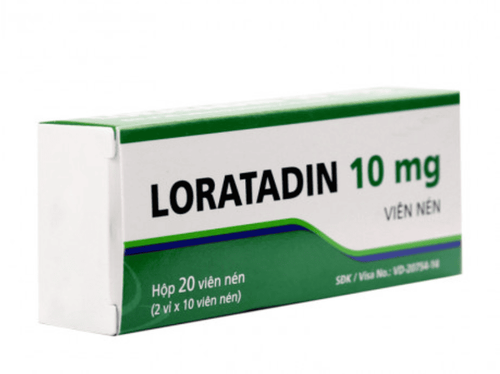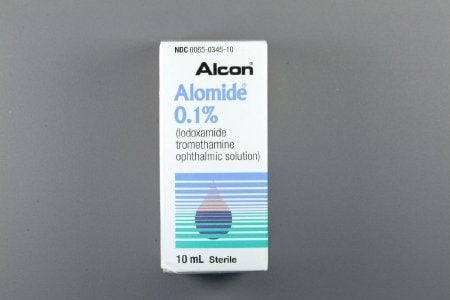This is an automatically translated article.
Alcaftadine is indicated for the treatment of allergic conjunctivitis. The drug is prepared in the form of 0.25% eye drops and should be used according to the dose recommended by the doctor to promote the best effect.1. What is Alcaftadine?
Alcaftadine is a histamine H1 receptor antagonist, used to treat and prevent eye redness, itching, or discomfort associated with allergic conjunctivitis. Alcaftadine was approved in 2010 and is available as an eye drop solution with a concentration of 0.25%. Patients with red eyes due to wearing contact lenses should consult a specialist before using Alcaftadine.2. Uses of the drug Alcaftadine
Pharmacokinetics:
Alcaftadine is an antihistamine and inhibits the release of histamine H1 from mast cells. In addition, this active substance has also been shown to inhibit eosinophil activation and reduce chemotaxis. Pharmacodynamics:
After instilling 0.25% Alcaftadine solution in both eyes, the mean plasma Cmax of the active substance will reach about 60 pg/mL and the median Tmax may occur after 15 minutes. On the other hand, plasma concentrations of Alcaftadine were below the lower limit of quantification within 3 hours of instillation, namely 10 pg/mL. The mean Cmax of the carboxylic acid metabolite is 3 ng/mL, which tends to occur about 1 hour after dosing. The plasma concentration of carboxylic acid was below the lower limit of quantification approximately 12 hours after instillation, namely 100 pg/mL.
3. Dosage and how to use Alcaftadine
3.1. Dosage of Alcaftadine
Dosage of Alcaftadine drug to treat allergic conjunctivitis will depend on certain patients, specifically:
Usual dose of Alcaftadine for adults: Put 1 drop in each eye, 1 day per day. time; Usual Alcaftadine Dose for Children over 2 years: One drop in each eye and once a day. 3.2. How to use Alcaftadine Alcaftadine drug is prepared in the form of eye drops and should be used exactly as directed by your doctor about the amount and frequency to ensure the best use of the drug. In addition, patients also need to carefully study the information about the drug Alcaftadine before deciding to use it to determine the right drug for their medical condition. Ideally, you should instill Alcaftadine solution at a certain time of day to limit the risk of missing a dose.
Here are the instructions when using Alcaftadine eye drops, including:
Wash your hands before instilling the eye drops to prevent infection, absolutely do not touch the dropper tip or place the vial directly. contact with eyes or other surfaces. When instilling Alcaftadine, the patient should sit in a comfortable position, keeping the head slightly tilted back and eyes up. Then, gently pull the eyelid down with your hand and put the tip of the medicine on the top, gently squeeze the bottle to let the solution slowly drip down. After instilling the drug, the patient should look down gently to avoid the medicine flowing out of the corner of the eye. It is best to close your eyes for 1-2 minutes and avoid rubbing or blinking with your hands. If there is liquid solution coming out, you can wipe it off with a towel, after about 15 minutes you can put your contact lenses back on. If the patient is taking other medications for the eyes, it is best to leave a gap of at least 5 minutes between medications to avoid interactions. During the use of alcaftadine, if you notice that your allergic conjunctivitis does not improve or has a bad change, you should immediately notify your doctor for timely solutions.
To help achieve optimal results, patients should take Alcaftadine regularly and fully every day. Besides, you also need to carefully check the quality of the drug, if you notice the solution turns black, stop taking the medicine immediately. The use of anabolic steroids can increase the severity of eye allergies and cause infections and loss of vision.
4. Some side effects of the drug Alcaftadine
Along with some important uses, Alcaftadine can cause side effects for patients during use. When noticing the presence of any of the following symptoms, the patient should immediately contact a doctor for remedial measures, specifically:
There is a stinging or burning sensation in the eyes; eye itching, pain, or redness; Diarrhea, fever, cough, headache; There is a feeling of discomfort in the eyes; Joint pain, loss of appetite; Runny nose, shivering, nausea, vomiting, muscle aches; Sore throat, feeling stuffy or runny; Sweating, weakness, or unusual tiredness; Difficulty sleeping, disrupted sleep at night. 5. Important notes when taking Alcaftadine Before taking Alcaftadine, patients should note a few things below:
Inform your pharmacist or specialist about your history of allergy to the active ingredient. Alcaftadine or any of the excipients in the drug. Tell your doctor about all prescription and OTC medicines, herbs, supplements, vitamins or supplements you are taking. Tell your doctor if you are pregnant or planning to have a baby or are breastfeeding. Avoid wearing contact lenses when your eyes are irritated, irritated or red because the lenses can absorb the Benzalkonium chloride in the medicine. You should only put your glasses back on for at least 15 minutes after instilling the drops. There is still insufficient evidence that alcaftadine poses a risk to pregnant or nursing women. According to the FDA, the drug Alcaftadine belongs to group B for pregnancy, you can refer to the information on classification of drugs by group for pregnant women below, specifically:
Group A: No risk; Group B: Low risk in some studies; Group C: Likely to be at risk; Group D: There is evidence of the risk of the drug; Group X: Contraindications to drug use; Group N: No information available, need to consult a doctor. 6. Alcaftadine drug interactions Interactions of Alcaftadine drugs with other drugs can change the drug's mechanism of action, even increasing the influence of side effects. Alcaftadine is not known to interact specifically, so patients should talk to their doctor if they want to take the drug along with other medications that are being used to treat other conditions. In addition, patients should also avoid using Alcaftadine on their own, stop or adjust the dose without the guidance of a specialist.
7. Alcaftadine storage instructions Alcaftadine medicine should be stored at a suitable temperature, preferably below 30 degrees Celsius, away from moisture and exposure to sunlight. You absolutely should not store medicine in the freezer as well as the bathroom because this can seriously affect the quality of the medicine, easily lose its effectiveness and increase the risk of damage to the eyes.
Before and during the use of Alcaftadine, you should carefully read the instructions printed on the medicine packaging or consult your doctor. Store Alcaftadine in a dry place, away from children or pets.
For Alcaftadine that has expired or is damaged, you should dispose of the medicine according to the procedure recommended by the specialist. Avoid throwing medicine or flushing it down the toilet or water pipe to avoid the risk of contamination.
Please dial HOTLINE for more information or register for an appointment HERE. Download MyVinmec app to make appointments faster and to manage your bookings easily.
Reference source: drugs.com












